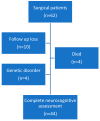Oxidative Stress and Indicators of Brain Damage Following Pediatric Heart Surgery
- PMID: 35326139
- PMCID: PMC8944849
- DOI: 10.3390/antiox11030489
Oxidative Stress and Indicators of Brain Damage Following Pediatric Heart Surgery
Abstract
Pediatric cardiac surgery induces an increased oxidative stress (OS) response. Increased OS is associated with poor neurologic outcomes in neonatal populations with similar patterns of brain injury. We investigated OS and brain injury in infants undergoing heart surgery. Patients 6 months or younger, undergoing cardiac surgery with or without cardiopulmonary bypass (CPB), were included in this prospective, observational study. Patients were divided into infant (30 days−6 months) and neonatal (<30 days) groups for analysis. Urine OS biomarker 8-iso-prostaglandin F2α (8-iso-PGF2α) was quantified pre-surgery and at 0 and 24 h post-surgery. A serum brain damage biomarker S100B protein was also measured pre-surgery and at 0 and 72 h post-surgery. Amplitude-integrated electroencephalography during surgery was analyzed. Neuropsychological evaluation using the Bayley III or Vineland test was performed in all patients at 24 months of age. Sixty-two patients were included, 44 of whom underwent follow-up neurologic evaluation. 8-iso-PGF2α and S100B levels were increased after surgery. Postoperative levels of S100B were positively correlated with 8-iso-PGF2α levels 24 h after surgery (rho = 0.5224; p = 0.0261). There was also a correlation between immediate post-surgery levels of 8-iso-PGF2α and intra-surgery seizure burden (rho = 0.4285, p = 0.0205). Patients with an abnormal neurological evaluation had increased levels of S100B 72 h after surgery (p = 0.048). 8-iso-PGF2α levels 24 h after surgery were also related to abnormal neurologic outcomes. Levels of 8-iso-PGF2α following pediatric cardiac surgery are associated with several indicators of brain injury including brain damage biomarkers, intra-operative seizures, and abnormal neurological evaluation at follow-up, suggesting the importance of oxidative stress response in the origin of brain damage in this population.
Keywords: 8-iso-prostaglandin F2α; S100B protein; oxidative stress; pediatric cardiac surgery.
Conflict of interest statement
The authors declare no conflict of interest. The funders had no role in the design of the study; in the collection, analyses, or interpretation of data; in the writing of the manuscript, or in the decision to publish the results.
Figures






Similar articles
-
Oxidative stress response in children undergoing cardiac surgery: Utility of the clearance of isoprostanes.PLoS One. 2021 Jul 6;16(7):e0250124. doi: 10.1371/journal.pone.0250124. eCollection 2021. PLoS One. 2021. PMID: 34228731 Free PMC article.
-
Serum Neuronal Biomarkers in Neonates With Congenital Heart Disease Undergoing Cardiac Surgery.Pediatr Neurol. 2017 Jul;72:56-61. doi: 10.1016/j.pediatrneurol.2017.04.011. Epub 2017 Apr 21. Pediatr Neurol. 2017. PMID: 28571730
-
Associations of plasma 8-iso-prostaglandin F2αlevels with fasting blood glucose (FBG) and intra-abdominal fat (IAF) area in various Glycometabolism populations.BMC Endocr Disord. 2021 Oct 28;21(1):215. doi: 10.1186/s12902-021-00879-3. BMC Endocr Disord. 2021. PMID: 34711211 Free PMC article.
-
Raftlin and 8-iso-prostaglandin F2α levels and gene network analysis in patients with Modic changes.Eur Spine J. 2023 Jul;32(7):2368-2376. doi: 10.1007/s00586-023-07757-7. Epub 2023 May 19. Eur Spine J. 2023. PMID: 37208489
-
Assessment of lipid peroxidation by measuring malondialdehyde (MDA) and relatives in biological samples: Analytical and biological challenges.Anal Biochem. 2017 May 1;524:13-30. doi: 10.1016/j.ab.2016.10.021. Epub 2016 Oct 24. Anal Biochem. 2017. PMID: 27789233 Review.
Cited by
-
Early versus late parenteral nutrition in term and late preterm infants: study protocol for a randomised controlled trial.BMC Pediatr. 2022 Aug 30;22(1):514. doi: 10.1186/s12887-022-03569-8. BMC Pediatr. 2022. PMID: 36042439 Free PMC article.
-
Early versus late parenteral nutrition in term and late preterm infants: a randomised controlled trial.BMJ Paediatr Open. 2024 May 12;8(1):e002579. doi: 10.1136/bmjpo-2024-002579. BMJ Paediatr Open. 2024. PMID: 38735834 Free PMC article. Clinical Trial.
-
The association between prenatal oxidative stress levels measured by isoprostanes and offspring neurodevelopmental outcomes at 36 months.Brain Behav Immun Health. 2024 Apr 24;38:100775. doi: 10.1016/j.bbih.2024.100775. eCollection 2024 Jul. Brain Behav Immun Health. 2024. PMID: 38706573 Free PMC article.
-
Electrical impedance tomography provides information of brain injury during total aortic arch replacement through its correlation with relative difference of neurological biomarkers.Sci Rep. 2024 Jun 20;14(1):14236. doi: 10.1038/s41598-024-65203-0. Sci Rep. 2024. PMID: 38902461 Free PMC article.
-
Neuromonitoring modalities predicting neurological impairment in pediatric congenital heart disease: a systematic review.Front Neurol. 2024 Dec 18;15:1502762. doi: 10.3389/fneur.2024.1502762. eCollection 2024. Front Neurol. 2024. PMID: 39744107 Free PMC article.
References
-
- Hadley S., Cañizo Vazquez D., Lopez Abad M., Congiu S., Lushchencov D., Camprubí-Camprubí M., Sanchez-de-Toledo J. Oxidative stress response in children undergoing cardiac surgery: Utility of the clearance of isoprostanes. PLoS ONE. 2021;6:e0250124. doi: 10.1371/journal.pone.0250124. - DOI - PMC - PubMed
Grants and funding
LinkOut - more resources
Full Text Sources
Miscellaneous

